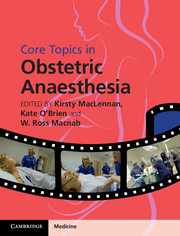Book contents
- Frontmatter
- Contents
- List of contributors
- Preface
- Section 1 Basic science, epidemiology and service organization
- Section 2 Obstetric aspects
- Section 3 Provision of anaesthesia
- 8 Incidental anaesthesia during pregnancy
- 9 Non-regional analgesia techniques for labour
- 10 Regional analgesia techniques for labour
- 11 Regional anaesthesia for operative delivery
- 12 General anaesthesia for caesarean section and transverse abdominal plane block
- 13 Anaesthesia for other obstetric indications: cervical suture, external cephalic version, controlled ARM, manual removal of placenta and perineal repair
- Section 4 Medical conditions in pregnancy
- Section 5 Postpartum complications and obstetric emergencies
- Section 6 Service organization
- Index
- Plate section
- References
8 - Incidental anaesthesia during pregnancy
from Section 3 - Provision of anaesthesia
Published online by Cambridge University Press: 05 December 2015
- Frontmatter
- Contents
- List of contributors
- Preface
- Section 1 Basic science, epidemiology and service organization
- Section 2 Obstetric aspects
- Section 3 Provision of anaesthesia
- 8 Incidental anaesthesia during pregnancy
- 9 Non-regional analgesia techniques for labour
- 10 Regional analgesia techniques for labour
- 11 Regional anaesthesia for operative delivery
- 12 General anaesthesia for caesarean section and transverse abdominal plane block
- 13 Anaesthesia for other obstetric indications: cervical suture, external cephalic version, controlled ARM, manual removal of placenta and perineal repair
- Section 4 Medical conditions in pregnancy
- Section 5 Postpartum complications and obstetric emergencies
- Section 6 Service organization
- Index
- Plate section
- References
Summary
Introduction
Parturients may require anaesthesia during their pregnancy in order to facilitate obstetric or non-obstetric surgical procedures. Common obstetric procedures required in pregnancy include cervical cerclage, ovarian cyst interventions and fetal surgery. The incidence of incidental or non-obstetric anaesthesia in pregnancy has been reported as ranging from 1:50–150 pregnancies, with appendectomy, cholecystectomy and pelvic laparoscopy being the most commonly encountered procedures.
Incidental anaesthesia must minimize the risk of interrupting the pregnancy and affecting fetal development. Alterations in maternal physiology accentuate anaesthetic risks and the approach to anaesthesia must be modified accordingly.
Fetal considerations
Anaesthesia may impact on the fetus in two ways: it may interrupt the pregnancy, resulting in either pregnancy loss or premature delivery, or it may impact on fetal development, either by teratogenic pharmacological effects or because of derangements in the physiological milieu.
The effects of a teratogenic insult depend on the gestation of the fetus at the time of exposure. Teratogens cause an ‘all or nothing’ effect in the early pluripotential developmental phase, such that the embryo will either die or be unaffected and develop normally. However, days 31 to 71 of human gestation correspond to the organogenesis phase, where exposure to teratogens may impair the structural development of organ systems. First trimester anaesthesia has been linked with increased neonatal central nervous system and eye malformation, particularly hydrocephalus and cataracts. In the phase following organogenesis, teratogen exposure is more likely to affect the fetal central nervous system, which undergoes development and maturation throughout pregnancy. These effects are likely to result in functional behavioural effects rather than structural malformations.
Drug teratogenicity
Organogenesis phase
There is theoretical reason to suspect that drugs used in anaesthesia may be teratogenic: the cellular mechanisms for differentiation and organogenesis include mechanisms known to be targeted by drugs used in anaesthesia. Neurotransmitter and receptor mechanisms, as well as signalling and second messenger systems are all known to be affected by drugs used in anaesthesia. This theoretical risk of teratogenicity has been difficult to quantify in a practical clinical context, because of difficulties extrapolating animal research data to human development (teratogenicity is species specific) and the obvious ethical and logistical problems of research on human fetal exposure to teratogens.
- Type
- Chapter
- Information
- Core Topics in Obstetric Anaesthesia , pp. 49 - 53Publisher: Cambridge University PressPrint publication year: 2015



